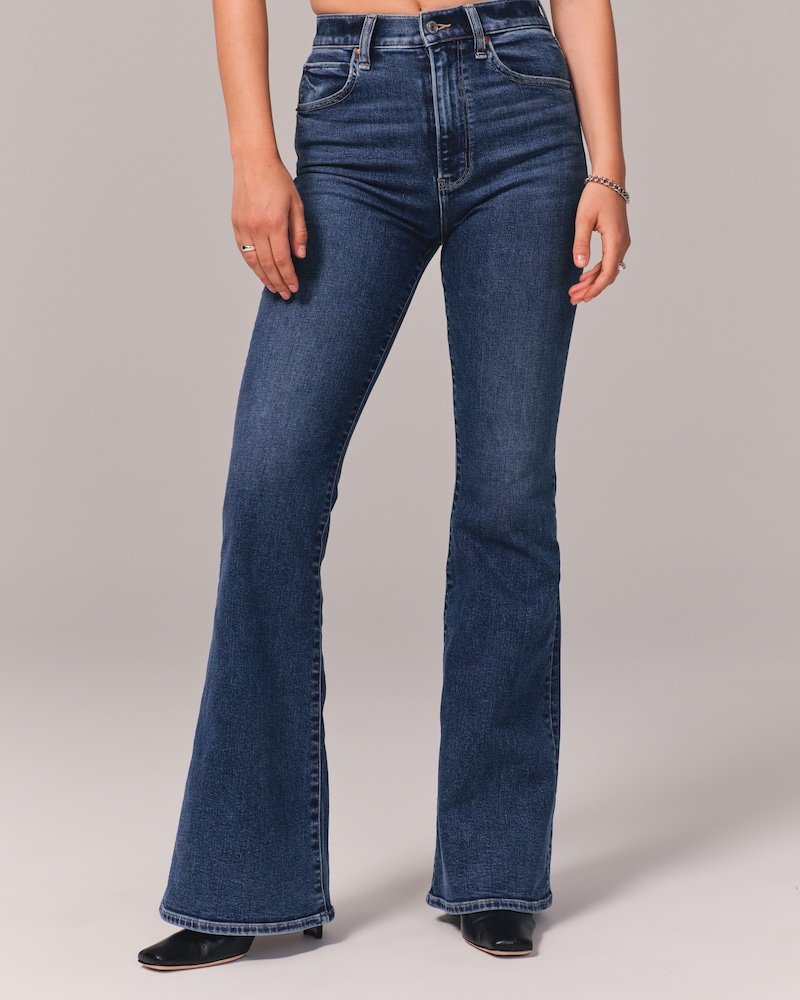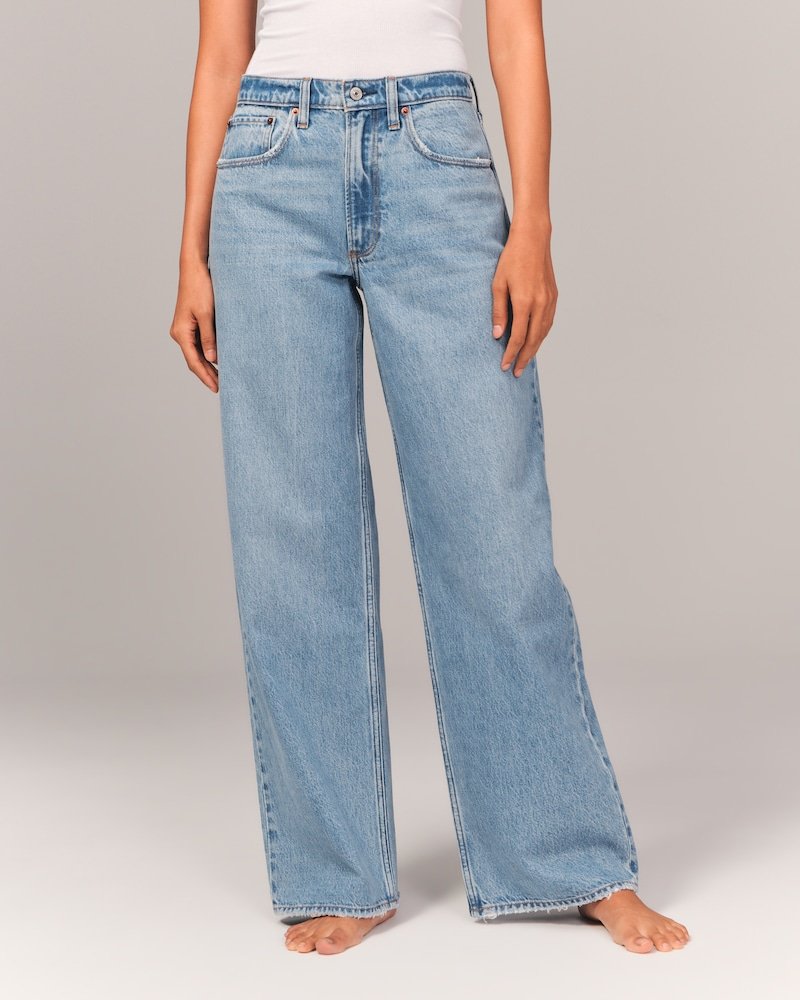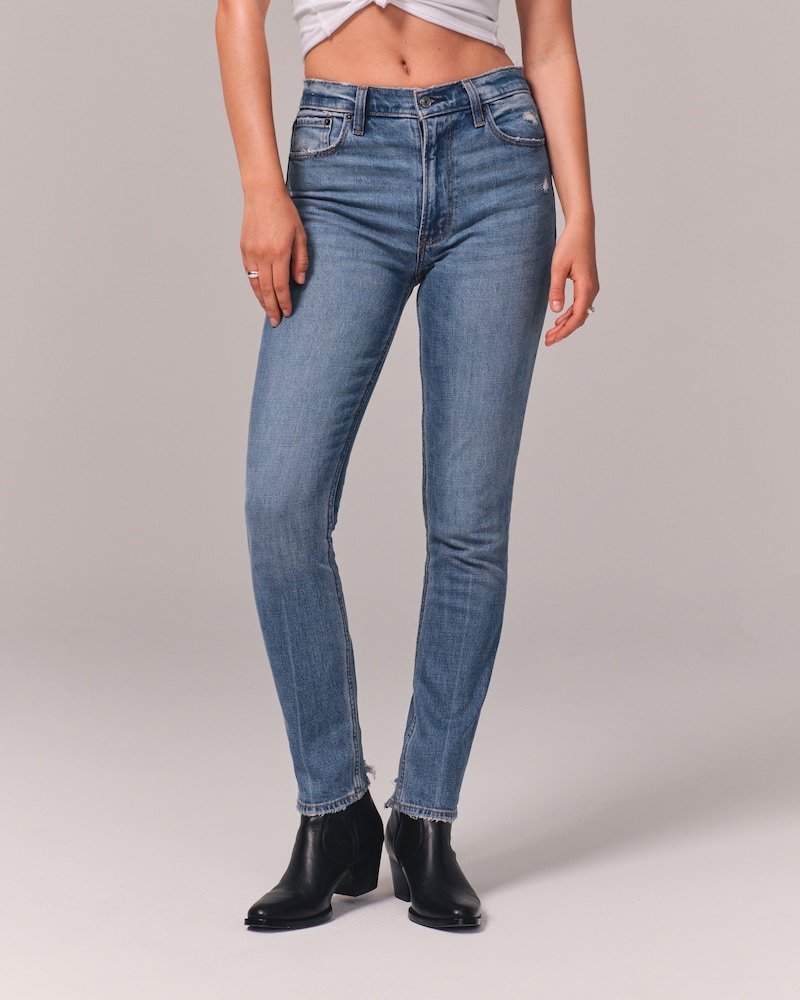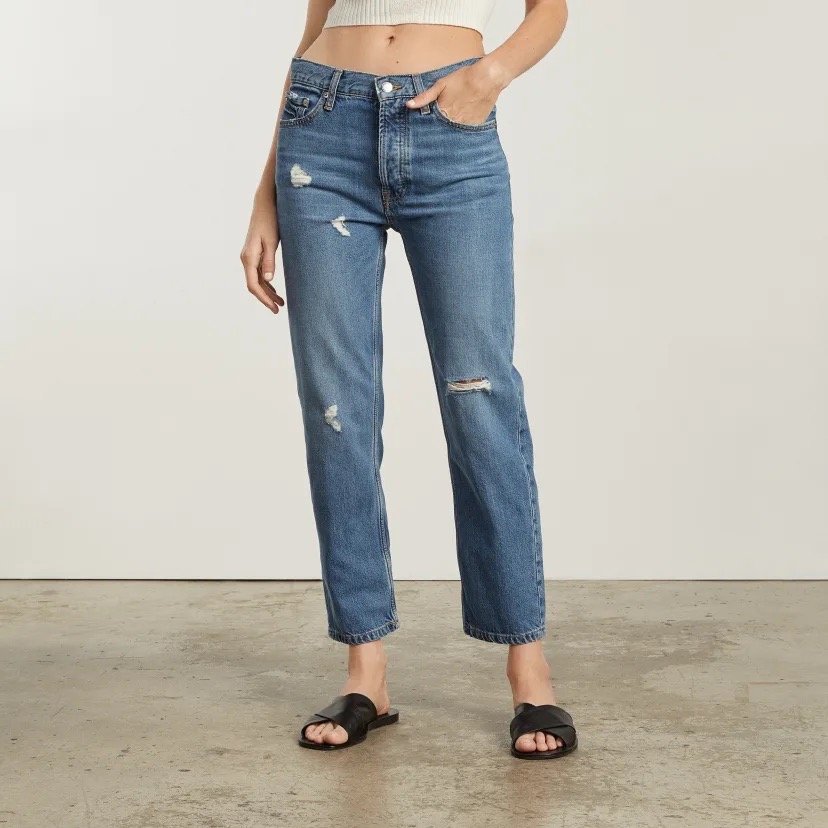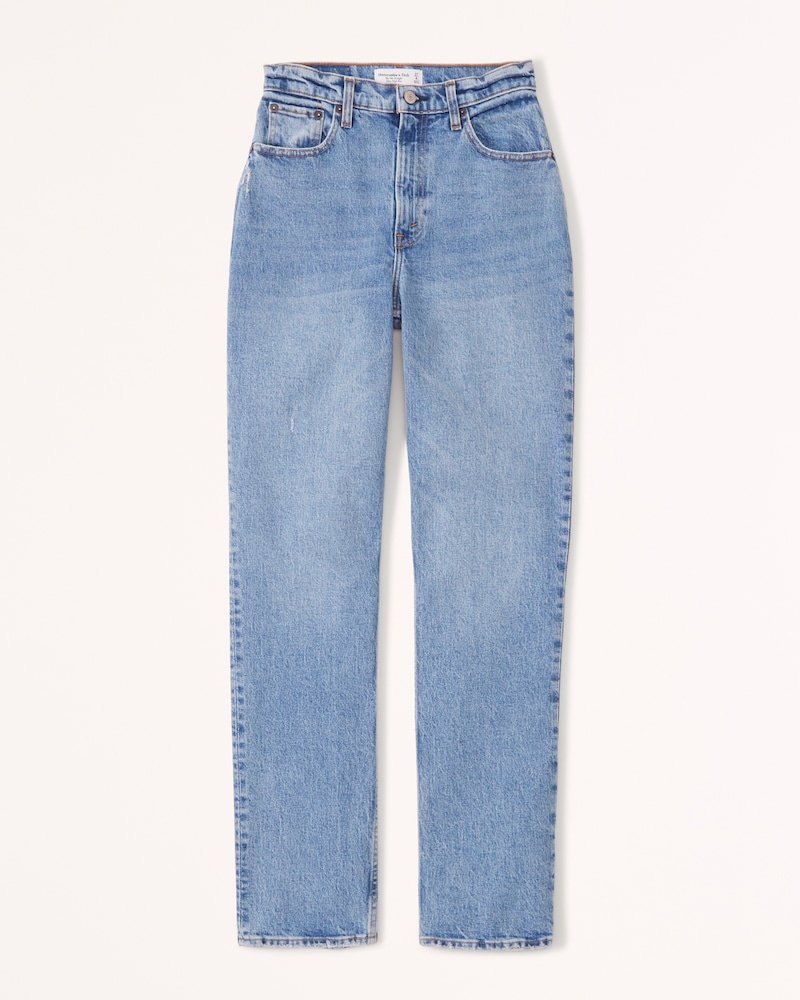the denim edit
women’s pants are ~confusing~ to say the least. As much as trousers are on the rise, denim will never go away. A pair of good jeans is a must-have in every closet - no matter your aesthetic. Thank goodness we’re finally getting some options and every pair of jeans in stores aren’t just more of the same. This makes finding your perfect pair of denim so much more worthwhile, as you can actually find something for you. So the real question is…how do you pick the right pair? Here is everything you will ever need to know about denim:
denim styles 101
bootcut
this silhouette follows the line of your body until the top of your calf and flows down or slightly out - a hybrid between a straight and a flare. Beware if you have larger calves (like me), as some bootcut styles can end up looking more like straight leg pants if they hug your calves too tightly, flowing down from below the widest point of your calf.
a great option to balance out a hip, this style works on pretty much every body type. The challenge is to find a pair that actually works with your body’s proportions. A great bootcut will fit as I outlined above, but everyone’s leg proportions are different; and so the cut of a specific pair of bootcuts might not actually be right for you. If that’s the case, know its the design of the denim, not you, and move on to the next pair!
kick crop / demi-boot
a cropped pair of denim (above the ankle) that have the same silhouette as a bootcut.
cropped pants can emphasize width and shortness - cropped pants crop you. People with short torsos or long legs often gravitate towards these, as they can balance those features out.
flares
also known as bell bottoms (although some would say there is a difference and bell bottoms are flares to the max - they are tighter on the knee and flare even wider). Flares will follow the line of the body until the knee and then flow outwards. A general rule of thumb: if the leg opening is 21” or greater, the pants are flared and not just a bootcut. I will say though, that it totally depends on the width of your calf compared to the opening of the pant, as pants advertised as flares can appear as bootcut on those of us with wide calves.
flares are very similar to bootcut, but they add extra curve. If you’re looking to emphasize curves in your lower half, while still maintaining balance, these work great for that.
wide leg
I love these for a more dressed up look, especially in a darker wash. They are reminiscent of my trousers. These should flow outwards from the hip.
I may be biased, but I think everyone should own a pair of wide leg jeans. They’re comfortably breezy, look very chic, and can balance out width in the hips, midsection, chest, and shoulders. When full length, they extend the leg, as there is no break for the eye from top to bottom. The only body that might feel overwhelmed by these is someone who is very slender with a very petite upper body.
culotte
wide-leg but cropped above the ankle. If they’re extra short (end mid-calf) they are gaucho pants.
same as the kick crop; cropped pants have a shortening effect. You can balance this effect out with shoes that match your skin colour, or sock boots that rise above the pants hem.
skinny
tight all the way through, even around the ankle. Hugs the body, and generally has at least 2% elastane and some polyester.
this silhouette does not create balance in your shape, as it allows any visual weight to be maintained from shoulder to hip (assuming most people have ankles smaller than their hips, waist, shoulders, etc). It can emphasize curves (if you already have them), or straightness (if you are not curvy). They essentially follow the entire line of your body and will therefore emphasize what’s already there. Chunky shoes, especially boots, can add balance to this look; or a long, oversized top can create harmony within the overall outfit. Great for being tucked into winter boots, and worn under a long winter coat.
jegging
the skinny, with more elastane than cotton - some with more than 70% elastane. Literally, a jean-legging hybrid.
same as the skinny, without the structure. I’m not sure why these exist tbh - just wear comfy pants, like leggings or joggers, or opt for trousers with stretch.
slim
very similar to the skinny, but with room around the ankle. People often get the two confused, as the slim leg will look differently on different body types. If you are curvier (like myself), certain slim fits can become skinny jeans on your body. This is why it’s best to ignore labels, and shop with the end result in mind, rather than the starting point. These can also be called Cigarette jeans.
a hybrid between the skinny and the straight leg, these can emphasize curve while bringing slight balance. A little room around the ankle can actually make a big difference.
straight
these should fall straight down from the thigh and just hug the bum; however, on the majority of women, this doesn’t happen. This is why there is so much confusion between skinny/slim/straight terminology. On most women, a straight leg will appear more like a slim fit, following the line of the body with room around the ankle. The straight leg can also parade around as bf, gf, mom, or dad jeans, so you really just never know. Again, ignore the labels, shop for the result.
these are great for keeping most shapes balanced and lengthening the legs, without having a dramatic or fussy silhouette. They smooth over curves without overly emphasizing them. If you have very broad shoulders or a large chest and narrow hips, these can emphasize width in those areas, creating a top-heavy silhouette.
boyfriend
a loose, relaxed fit (often literally called ‘relaxed fit denim’) that should be a little baggy all over. Boyfriend jeans are supposed to be low-rise; but since definitions are as loose as the pants themselves, most boyfriend fits are now high rise, as that style has taken over. These should be cropped just above the ankle (or rolled). If all of that is confusing, think skater boi.
the relaxed fit will balance out broad shoulders, a large chest, or thicker midsection, as boyfriends add visual weight to your lower half. This shrinks your top half in comparison to the heavy silhouette of the pants. As they often add bulk to the hip, and have a horizontal line that’s lower on the body, these don’t balance out a pear or hourglass shapes as well as wide leg pants (as wide legs don’t add bulk to the hips).
girlfriend
basically boyfriend jeans, but with a mid to high rise. Hence, confusion. Often distressed or stone washed.
similar to the boyfriend, but these will also lengthen the lower half, as the rise is higher.
mom
essentially tapered pants. They have a looser silhouette throughout the thigh and the seat, similar to girlfriend/boyfriend denim, but instead of going straight down throughout the leg, they taper (narrow) in towards the ankle. Always a high rise, sometimes referred to as “vintage fit,” “80s,” or “90s denim” (although straight leg jeans can also be called “90s”).
similar to the straight leg, with the guaranteed high-rise. The biggest dislike for mom jeans often arises from the lack of lift in the booty department, or ill-fitting pairs in general. But find the right pair for you, and these are great.
dad
relaxed fit throughout. Dad jeans are very similar to boyfriend jeans, but with a high rise and a longer, full-length inseam. Generally both mom and dad jeans come in a mid-wash, giving a worn, vintage look.
these have a similar effect to the wide leg, which is why I prefer them over the rest of the family (mom/boyfriend/girlfriend).
my favourite pairs
other denim attributes and what they mean for you:
whiskering / highlighting - where there’s a highlight on your denim, there’s a spotlight on your body. Be aware of where these light patches fall as they draw the eyes directly to them. You can use these to your advantage: if you’d like wider or curvier hips, find denim with whiskering there; if you’d like a plumper bottom, a bit of highlight can help.
wash - for a more lengthening look, keep denim shades similar to the rest of your outfit (ie, light top + light bottoms; dark top + dark bottoms). This works similar to monochromatic outfits, creating a path for your eye to travel vertically from head to toe. Pairing a white top with dark wash jeans will break the eye, cutting your body at the waistline - drawing your eye right to the break, and shortening you.
rise - choose that which is most comfortable to you (as I explain below). But, if you’re looking to lengthen, high rise is the way to go. Remember, wherever that waistline falls (especially if you pair with a contrasting top) the eye will be drawn there, highlighting that horizontal line.
fabric weight - the thicker the fabric, the more structure the denim will provide. I talk more about fabric down below, but my opinion is your jeans should be denim. Heavy elastane and polyester counts are only necessary when your jeans are skin tight, and glued to your body. If you want to be comfortable in your jeans, wear other pants. I have many trousers that look professional, but feel like sweatpants. And there are many sweatpants and loungewear pants that look cute. Comfy hang-out jeans just shouldn’t be a thing. But that’s just my opinion.
pockets - butt pockets with flaps add volume to your behind - which is great if you want a curvier bum. Pockets should be in proportion to your butt, otherwise it can look a little off. Too small, and your bum looks disproportionately large with no definition; too big, and they can diminish your butt altogether. When the pockets tilt inwards, this can give the appearance of an hourglass behind. Pockets that are far apart will make the butt look wider; pockets that are close together will make the butt look narrower. Ideally, the bottom point of the pocket should nest right at the base of where your butt meets your thigh. Pockets that are too high set can make your bum look saggy, but can also lengthen your legs, so it’s all about balance. Right now, I would say having high-set pockets is really on trend (this is what’s on most mom jeans…creating “mom butt”). That’s why it’s totally about what works for you: I don’t think any pocket in particular is universally flattering, it’s just about knowing the look that you want to achieve.
yoke - this is the V seam at the back of your denim; the stretch of fabric between the pocket area and your waistband. A soft V-shaped seam can add shape to your bottom, providing some lift; a straight line can make for a boxy booty; a low yoke gives a more relaxed look.
what’s the deal with Curve?
If you have a large hip to waist ratio, like me, Curve denim lines can be a great option. Some brands, like Old Navy, advertise a 1” smaller measurement in the waist (making pant sizes all the more confusing as sizing is supposed to be based on waist measurement…do I keep my regular waist size? Do I size up? Especially if you’ve never bought their regular jeans before…who knows?) and a 1” larger measurement in the hips. Other brands, like Abercrombie, simplify this and offer a 2” increased measurement just in the hips (but from my experience, I feel like their waist measurement is decreased as well). Some brands, like Madewell, don’t offer the exact measurement increase, simply stating that the waist is slimmer and there’s more room throughout the hips and thighs, which is obviously very arbitrary. And a lot of brands, in general, just add stretch to their denim and call it a day. If you’re curvy, Curve lines can be a great option, yes, but I’d say it definitely takes some trial and error, especially when shifting from brand to brand.
your guide to rise
rise measurements and their classifications (high, mid, and low) are pretty standardized across the board. But what isn’t standardized, is the rise that you need. While high rise is often touted to be the most flattering, as it lengthens the legs, it’s not the ideal rise for everyone. If you already have exceptionally long legs and a short torso, a low or mid rise can offer more balance in your silhouette. As a person with a short torso, and a short frame in general, I actually find mid rises to be more comfortable, especially when sitting. Many high rises surpass the smallest point of my waist and dig into my ribcage causing me discomfort. Since mid rises often hit me at the smallest point of my waist, I find them the most flattering on my body as well. You can discover which rise will work best for you by measuring the distance from crotch to wherever you’d like the top of your pants to fall.
typical rise measurements:
high rise: 9-11” (many brands offer an ultra-high rise up to 12”)
low rise: 5-7”
mid rise: 7-9”
all about inseams
the inseam is measured from the crotch to the bottom hem of the pant, along the inside of your leg. Many suggest that the smallest point of the ankle is the most universally flattering place for denim to fall. I think it’s a lot more personal than that - it really depends on your chosen pants and the footwear you pair them with. I personally love a longer inseam, as it extends my legs and makes me look taller. The ideal length for me is between half an inch and an inch above the ground. While this length is obviously for wider jeans, even a straight leg pair can be worn a bit longer over the right pair of heels or boots. Tapered denim can look especially great rolled, and extra length is needed for that, so be sure to also consider whether you’d prefer to cuff your jeans when looking at inseams.
In the past, the only ways to get the appropriate denim length was to either take your pants to a tailor or hem them yourself. Thankfully, many retailers are now providing a short inseam (suggested for 5’3” and under…although be sure to look at the actual inseam measurement as everyone’s body proportions are different) and long inseams (suggested for 5’8” and taller). Abercrombie actually has extra short inseams available for some styles (under 5’0”) and extra long (over 5’11”) and I really hope they continue to expand on this and other brands follow suit.
With pant length, particularly with non-straight leg shapes, the shape is really dependant on leg proportions. There is a different distance between knee and hip or knee and ankle on individuals with different heights (and even on individuals with the same height tbh). Flares and bootcuts fitting well totally depends on whether or not the fabric is taken in directly at your knee, and hemming the pants does not help with this as it only alters the bottom distance (from knee to ankle). They need to be fit appropriately throughout the entire length of the denim.
what is denim? what materials should I look for?
Denim itself is 100% cotton twill (a type of thick weave) and traditionally dyed Indigo. Poly Cotton (also called polycore or polycot) is a polyester-cotton blend, and is often used to increase the lifespan of denim, add stretch, or to provide brighter, more steadfast colours. Polyester doesn’t naturally change shape over time as much as traditional denim, and won’t wrinkle, shrink, or fade as much either, and can be more durable. But polyester is a plastic, derived from petroleum - a non-renewable resource - and is therefore less sustainable than natural cotton. This also makes it less breathable, and it can hold on to smells more than natural fibres. Many people with sensitive skin (myself included) can’t wear poly- fabrics without experiencing some discomfort (I actually get a rash).
Stretch denim is made with synthetic fabrics like Lycra, Spandex, or Elastane (all the same fabric, just with different brand names). These also have a plastic base (polyurethane), but in my opinion actually have a good purpose for being made (they can stretch up to 8 times their size and are a lot more breathable than polyester). This makes for a great fabric for athletic gear and swimsuits. Their appearance in denim, though, can be attributed to fashion designer Peter Goulding, whose clothing shop was frequented by fashion icons Twiggy and Bowie in the late 70s. Stretch denims’ popularity didn't rise until the late 90s, when Lycra put out their “Nothing moves like LYCRA” campaign; but it wasn’t until 2007 that jeans became skintight thanks to the help of this body-hugging fabric. I personally feel like 1% Elastane to 99% Cotton is the holy grail recipe, as it provides comfort while still feeling like denim; it’s stiff enough to hold me in - in all the right ways - while not being too thin that my thighs bust through.
Thin, overly stretchy denim is an immediate, tell-tale sign for me that the jeans will probably not last too long; and that I’ll probably wind up with holes in the inner thigh, be a victim of saggy butt, or be constantly hiking up my jeans.
get the right fit
with all clothing, I really do recommend trying on different sizes in stores to see how they make you feel. You could be a size 8, but feel best in a 12, its really up to you and the look you want to achieve. Sometimes a simple change room try-on isn’t enough either: especially when trying a new silhouette, it often takes the eye some time to get used to it. If online shopping is more your thing, always, always, always check measurements and fit guides, and read reviews.
Unfortunately, women’s sizing just isn’t standardized (not even within a singular brand sometimes). I recommend at least knowing your inseam, rise, hip, and waist measurements, and having those handy in the notes app on your phone. Leg opening is another measurement brands will often have available (this can be helpful, especially with straight leg denim, as sometimes a straight leg pair can be skinny fit on a curvy body). Always fit your largest measurement. If this is your hips and you find even with curvy denim the waist to be too large, a belt or tailoring is your best option. If this is your midsection, having room in the thighs and seat is great, and even on trend, but if your prefer a more fitted look, tailoring throughout the leg is an option as well!
brands I’ve tried
I’ve said it before, and I’ll say it again: Abercrombie is the only place I shop for denim. I’ve tried so many other places and Abercrombie just doesn’t disappoint. If you’ve tried them in the past (pre-2017), don’t let that deter you. They have a new female CEO and they’ve been making moves. I always wait for a sale (they have sales once a month) to make them more affordable. I’d love to try more brands, but unfortunately Canada can be kind of limiting in terms of what ships here and what we have available in stores.
Old Navy jeans don’t hold up, and neither do American Eagle. I used to wear Gap pretty religiously, but that has since subsided since I’ve become an Abercrombie stan. Levis just don’t work for curvy girls without alterations. I’ve tried all of their styles and they just never fit quite right, if I can get into them at all (I have to size up to a 34, and I’m a 27 at Abercrombie, to get some pairs on my body and at that point, I would have to destroy the pants in the alteration process).
I’ve partnered with Universal Standard in the past and I really do love the fit of their denim, but they have a bit too much stretch for my preference (when I wear denim, I want to wear denim), but totally a preference thing. They’re a lot more inclusive than most brands though, as they carry size 00-40 in three inseams.
I don’t think designer denim is worth it - I’ve bought into it in the past (hello, True Religions) and jeans just get too much wear to be investing that kind of money for them. The only reason you should pay more for denim is to get more ethical, sustainable, or locally made pairs.
care tips
wash inside out with cold water and hang to dry (please, please, for the sake of your clothes, hang dry everything. The only things that should be put in your dryer are bedding and towels). If you’re hardcore, you can spot wash to maintain a “lived in” shape - especially with your favourite vintage Levis - and put your denim in the freezer overnight to kill germs and eliminate any lingering scents. This of course doesn’t work with stretch jeans, as they often need to be thrown into the dryer to return to their original shape.
how to style denim
I think this is probably the next question on your mind after getting through this marathon of a post, and while I’d love to touch on that here, it will have to be a topic for another time. Please let me know if this is something you’d like a breakdown of!
I know denim can be overly complicated, so I really just wanted to do a deep dive and lay it all out here for you to reference. I also have a corresponding YouTube video up now, and you can watch that here. This is just a taste of what you can expect from my upcoming style course! If you’d like to stay in the know of when that will be released, sign up for my newsletter here.


